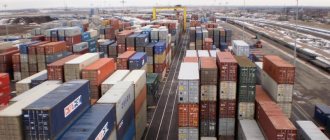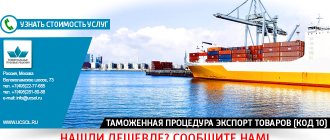HomeInformation Customs tariff
A customs tariff is a set of rates of customs duties that are imposed on goods when crossing the customs border. Rates are adjusted to a systematized list of product ranges. It is necessary to clarify that the customs border may not coincide with the borders of the state, and includes all points of departure and receipt of goods, for example, ports, airports, train stations. It may include the borders of states united in a customs union, on the territory of which a single customs tariff is applied.
Customs tariff structure
The structure of the customs tariff is based on the product range and customs duty rates. The customs tariff line includes: the product code, its name and description, and the corresponding rate values. A more complex structure may indicate various preferences, benefits, and quotas.
Types of customs tariffs
There are many classifications of customs tariffs. First of all, there are two types: simple and complex.
- Simple means that each product is subject to only one rate of customs duty, applied in any case.
- Complex means that each product is subject to several rates of customs duties (two or more). Almost all countries use complex customs tariffs, allowing for flexible application of customs duties.
Types of customs tariffs for the movement of goods:
- Import tariff.
- Export tariff.
The essence and purpose of applying a customs tariff is the management of foreign trade activities.
Purposes of application of the customs tariff
The use of a customs tariff allows you to achieve several goals:
- managing the flow of goods moving across the customs border to achieve an optimal balance between imports and exports;
- regular replenishment of the country's budget;
- protecting the interests of the country's commodity producers from competition with foreign goods;
- creating conditions for effective integration into the world economy.
In Russia, the first customs tariff was issued in 1724 during the reign of Peter 1. It was a list of imported and released goods in alphabetical order, indicating the duties collected. The amount of duty was set depending on the price of the product, its weight or measure. Since then, customs tariffs have changed several times.
Customs tariff of the Russian Federation
The customs tariff of the Russian Federation was put into effect on July 1, 1993 by the Law of the Russian Federation of May 21, 1993 No. 5003-01 “On the customs tariff.” It determined the procedure for applying the customs tariff, types of customs duties, types of customs duty rates, the procedure for their establishment, as well as tariff benefits (preferences). According to the adopted legislation, the rates of import customs duties are established legislatively by the Government of the Russian Federation. By Decree of the Government of the Russian Federation of November 27, 2006 N 718, the Customs Tariff of the Russian Federation was approved, which was in force before the creation of the Customs Union.
Unified customs tariff of the Customs Union (CU)
The Customs Union of the three countries of Russia, Belarus, and Kazakhstan was created in 2010, and its governing body was the Customs Union Commission (CUC). At first, complex integration processes were going on between the countries. The Unified Customs Tariff of the Customs Union came into force on January 1, 2012 by Decision of the Customs Union Commission (CUC) dated November 18, 2011 No. 850. The same document approved a new edition of the Unified Commodity Nomenclature. Since 2012, the Eurasian Economic Commission (EEC), which became the successor to the CCC, has become the supranational regulatory body of the Customs Union. During the same year, Resolution of the EEC Council of July 16, 2012 N 54 was adopted, which approved the new edition of the unified Commodity Nomenclature of Foreign Economic Activity of the Customs Union and the Unified Customs Tariff of the Customs Union (UCT CU). The adoption of these documents was caused by Russia's accession to the World Trade Organization (WTO) and the obligations undertaken in connection with this. Since Belarus and Kazakhstan were not members of the WTO, a transition period was established for these countries. The formed TS is an open organization, ready for new participants to join. In 2011, Kyrgyzstan expressed its intention to join, and approval was received in 2014. In 2013, Armenia expressed an intention to join, and approval was received in 2013. In 2014, Kyrgyzstan and Armenia became part of the Customs Union, but the current Customs tariffs of these countries differed from the Unified Customs Tariff of the Customs Union. For the newly joined countries, preferential conditions were in effect during the transition period, during which the rates of import duties on some goods remained the same. After the end of the transition period, the grace period ended and customs duties of the ETT CU came into effect.
Example. Until the end of the transition period, the rates of import customs duties on cars in Armenia were significantly lower than in other CU countries. For this reason, the cost of a car imported to Armenia from the USA was significantly lower compared to other CU countries. The imported car could be used throughout the entire territory of the vehicle.
Classification of goods in the Commodity Nomenclature of Foreign Economic Activity of the EAEU
To accurately classify a product item, it is necessary to have a good knowledge of the structure and purpose of the product (its defining properties), the principle of operation (to be able to identify the main functions), the material from which it is made, and sometimes you also need to know the manufacturing technology of the product.
The systematization is based on four main criteria:
- Material from which the product is made (physical and chemical composition)
- Product shape
- Purpose of the product, its main functions
- Degree of processing (processing)
An example of classifying a product based on the material of production would be a picture or photograph frame.
| EAEU HS Code | Name of product item | Group | Note |
| 4414009000 | WOODEN FRAMES FOR PICTURES, PHOTOS, MIRRORS OR SIMILAR OBJECTS MADE OF OTHER WOOD | Group 44 Wood and wood products; charcoal | For frames made of wood |
| 3926400000 | FIGURES AND OTHER DECORATIVE ITEMS OF PLASTICS AND OTHER MATERIALS OF COMMODITY ITEMS 3901-3914 | Group 39 Plastics and products made from them | For frames made of plastic |
| 8306300000 | FRAMES FOR PHOTOGRAPHS, PICTURES AND SIMILAR FRAMES; MIRRORS | Group 83 Other products of base metals | For metal frames |
An example of classifying a product by its shape is toilet soap.
| EAEU HS Code | Name of product item | Note |
| 3401110001 | TOILET SOAP (INCLUDING SOAPS CONTAINING MEDICINES) | If the soap is in the form of bars, pieces, etc. |
| 3401201000 | SOAP IN FORMS: FLAKES, WAFFLES, GRANULES OR POWDERS | If the soap is in the form of flakes, granules or powders |
| 3401209000 | OTHER SOAPS IN OTHER FORMS | Soap in liquid or paste form |
An example of classifying a product by its functions is a telephone.
| EAEU HS Code | Name of product item | A comment |
| 8517110000 | TELEPHONE DEVICES FOR WIRED COMMUNICATIONS WITH WIRELESS HANDSET | Telephones using a wired connection |
| 8517120000 | TELEPHONES FOR CELLULAR OR OTHER WIRELESS COMMUNICATION NETWORKS | Cellular phones |
Let us consider the criterion of separation according to the degree of processing using the example of silk products.
| EAEU HS Code | Name of product item |
| 5002000000 | RAW SILK (UNTWISTED) |
| 5004001000 | SILK THREAD (EXCEPT YARN FROM SILK WASTE), NOT PACKED FOR RETAIL SALE, UNBLEACHED, WASHED OR BLEACHED |
| 5006001000 | SILK THREAD FROM SILK WASTE, PACKED FOR RETAIL SALE |
| 5007903000 | OTHER FABRICS FROM SILK THREADS OR FROM SILK WASTE, DYED |
| 5007909000 | OTHER FABRICS FROM SILK THREAD OR FROM SILK WASTE, PRINTED |
Rules for determining the HS code
According to the provisions of the Customs Code of the Republic of Kazakhstan (hereinafter referred to as the Customs Code of the Republic of Kazakhstan), a participant in foreign trade activities independently determines the code of the goods transported across the customs border. If an incorrect classification of goods is detected when declaring them, the customs authority independently carries out the classification of goods (Article 78 of the Labor Code of the Republic of Kazakhstan).
Commissioners in the field of customs, at the request of an interested person, make preliminary decisions on the classification of goods (Article 78 of the Labor Code of the Republic of Kazakhstan).
Customs authorities, determined by the legislation of the member states of the Customs Union, can make decisions and give explanations on the classification of certain types of goods, ensuring their publication (clause 6 of Article 52 of the Customs Code of the Customs Union).
In order to ensure uniform interpretation of the Commodity Nomenclature of Foreign Economic Activity, based on proposals from customs authorities, the Commission of the Customs Union (Eurasian Economic Commission) adopts clarifications on the classification of certain types of goods (clause 7 of the Customs Code of the Customs Union).
Important
Before starting independent classification of goods, it is necessary to check the availability of a published decision on the classification of similar goods by the EEC or the Customs authorities of the Republic of Kazakhstan.
In general, the algorithm for determining the code comes down to the sequential application of six rules for classifying goods - the so-called Basic Rules for the Interpretation of the Commodity Nomenclature of Foreign Economic Activity (hereinafter - OPI Commodity Nomenclature of Foreign Economic Activity).
Rule 1
The names of sections, groups and subgroups are given only for ease of use of the Commodity Nomenclature of Foreign Economic Activity; for legal purposes, the classification of goods in the Commodity Nomenclature of Foreign Economic Activity is carried out based on the texts of commodity items and the corresponding notes
to sections or groups and, unless otherwise provided by such texts
Important
That is, when performing classification, it is necessary to focus primarily on the description of the composition of the group given in the classifier.
Carrying out classification based only on the name of the group is fundamentally wrong!
Rule 2
a) any reference in the title of a heading to any goods shall also be considered as a reference to such goods in an incomplete or unfinished form, provided that, being presented in an incomplete or unfinished form, such goods have the essential property of a complete or completed goods, and shall also be construed as a reference to a complete or complete good (or classified in the heading in question as complete or complete by virtue of this Rule) presented unassembled or disassembled;
b) any reference in the name of a heading to any material or substance must also be considered as a reference to mixtures or compounds of this material or substance with other materials or substances. Any reference to a product made of a particular material or substance shall be construed as a reference to goods consisting wholly or partly of that material or substance.
Classification of goods consisting of more than one material or substance is carried out in accordance with the provisions of Rule 3.
Rule 3
If, by virtue of Rule 2 (b) or for any other reasons, there is, prima facie, the possibility of classifying goods into two or more headings, the classification of such goods is carried out as follows:
a) preference is given to the heading that contains the most specific description of the product, compared to product items with a more general description. However, when each of two or more headings relates only to part of the materials or substances included in a mixture or multi-component article, or only to part of the goods presented in a set for retail sale, then these headings are to be treated as equivalent to this product, even if one of them gives a more complete or accurate description of the product;
b) mixtures, multi-component articles consisting of different materials or made from different components, and goods presented in sets for retail sale, the classification of which cannot be made in accordance with the provisions of Rule 3(a), shall be classified according to that material or component parts that give these goods an essential property, provided that this criterion is applicable;
c) goods, the classification of which cannot be carried out in accordance with the provisions of Rule 3 (a) or 3 (b), must be classified in the heading last in ascending order of codes among the headings equally acceptable for consideration in the classification of these goods .
Rule 4
Goods, the classification of which cannot be carried out in accordance with the provisions of the above rules, are classified in the heading corresponding to the goods that are most similar (close) to the goods in question.
Rule 5
In addition to the above provisions, the following rules must apply to the following goods:
a) cases and cases for cameras, musical instruments, guns, drawing supplies, necklaces, as well as similar containers having a special shape or adapted to accommodate the corresponding product or set of products, suitable for long-term use and presented together with the products for which it is intended, must be classified together with the products packaged in them, if this type of container is usually sold together with these products. However, this Rule does not apply to containers, which, forming a single whole with the packaged product, give the latter its main property;
(b) Subject to the provisions of Rule 5(a) above, packaging materials and containers supplied with the goods contained therein shall be classified together if they are of the kind usually used for packaging those goods. However, this provision is not mandatory if such packaging materials or containers are clearly suitable for reuse.
Unified customs tariff of the EAEU
On January 1, 2015, the Eurasian Economic Union (EAEU) was created, uniting 5 countries: Russia, Belarus, Kazakhstan, Armenia, Kyrgyzstan. By Decision of the EEC Council dated December 10, 2014 N 112, changes were made to the Decision of the EEC Council 54 as a result of which the CU was renamed the EAEU, and this is how the Common Customs Tariff of the Eurasian Economic Union (UCT EAEU) appeared. Customs duty rates were brought into line with the unified Commodity Nomenclature for Foreign Economic Activity (TN FEA), based on the Harmonized System for Description and Coding of Goods. This system consists of types of goods and the HS codes assigned to them, consisting of 10 digits. The unified customs tariff consists of 21 sections (97 groups) containing all types of goods. The rates of customs duties indicated in it are valid on the territory of all member countries of the EAEU, which allows for a unified customs policy.
Purpose and functions
A single customs tariff allows you to bring customs tariff rates in line with the product range of foreign trade activities and avoid financial losses, both on the part of the state and on the part of participants in foreign trade relations. The application of EAEU unified customs tariff makes it possible to:
- achieve an optimal balance between exports and imports by managing the flow of goods that move across the border;
- protect the interests of the country’s goods producers from competition with foreign brands;
- ensure effective integration into the world economy;
- regularly replenish the state budget.
Due to changes in the political situation customs tariffs , as well as their functions, have been repeatedly reviewed and adjusted.
Customs tariff 2021
The EAEU customs tariff in 2021 is not much different from the 2019 tariff. By decisions of the EEC, changes are made to the rates of import duties in the current Customs Tariff. In addition, new product items are being added to the list of goods.
Example. By decision of the EEC dated February 3, 2021 N 23, import customs duties on certain types of shellfish and krill meat with HS codes 0307433800, 0307439000, 0307529000, 1605400001 and 1605539000 were zeroed out.
We are sure that the timing, cost and quality of services will pleasantly surprise you!






